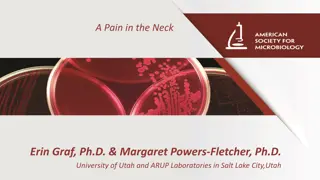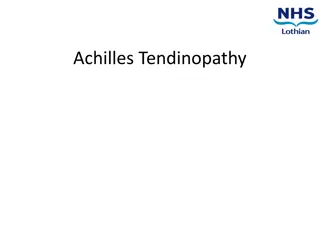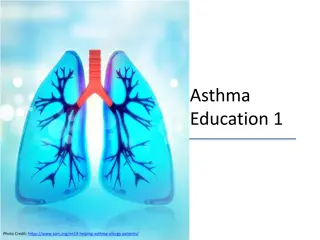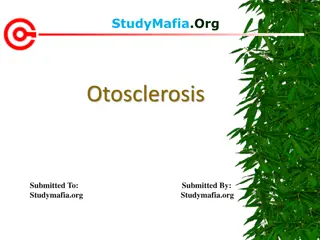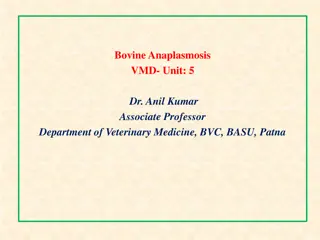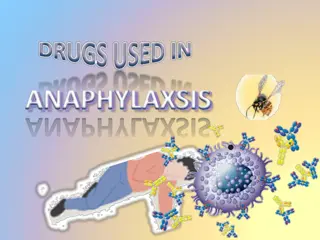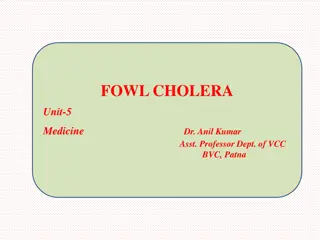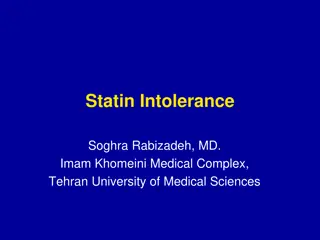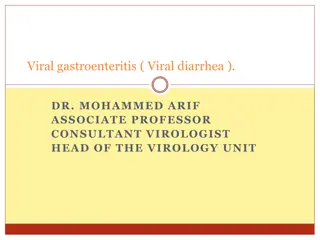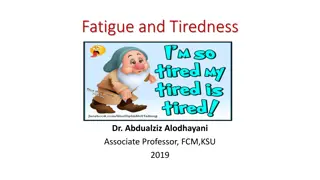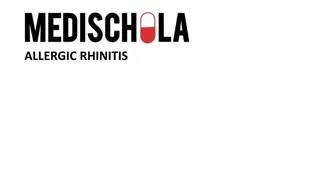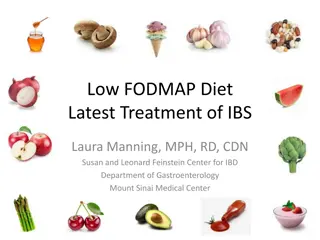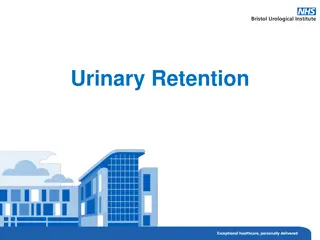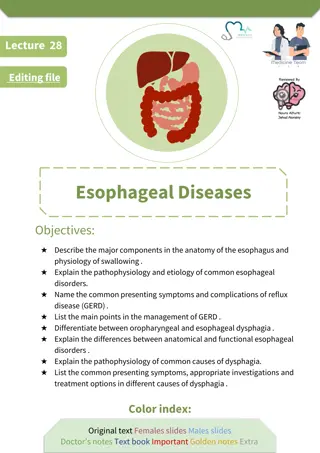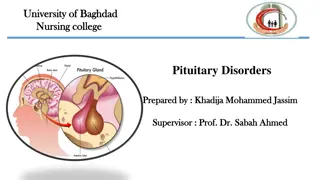Understanding Pharyngitis: Causes, Symptoms, and Management
Pharyngitis is an inflammation of the pharynx characterized by coughing, painful swallowing, and appetite changes. It can be caused by physical or infectious factors, leading to symptoms such as virtual obstruction, regurgitation, and drooling. Understanding the etiology and pathogenesis is crucial for diagnosis and management of this condition in animals.
Download Presentation

Please find below an Image/Link to download the presentation.
The content on the website is provided AS IS for your information and personal use only. It may not be sold, licensed, or shared on other websites without obtaining consent from the author. Download presentation by click this link. If you encounter any issues during the download, it is possible that the publisher has removed the file from their server.
E N D
Presentation Transcript
PHARYNGITIS PHARYNGITIS Hassanin Husham naser 2022
PHARYNGITIS Pharyngitis is inflammation of the pharynx and is characterized clinically by coughing, painful swallowing, and a variable appetite. Regurgitation through the nostrils and drooling of saliva may occur in severe cases.
ETIOLOGY Pharyngitis in farm animals is usually traumatic. Infectious pharyngitis is often part of a syndrome with other more obvious signs.
Physical Causes Injury while giving oral treatment with balling or drenching gun or following endotracheal intubation. Administration of a reticular magnet, resulting in a retropharyngeal abscess. Accidental administration or ingestion of irritant or hot or cold substances Foreign bodies, including grass and cereal awns, wire, bones, and gelatin capsules lodged in the pharynx or suprapharyngeal diverticulum of pigs.
Infectious Causes Cattle Oral necrobacillosis and actinobacillosis as a granuloma rather than the more usual lymphadenitis Infectious bovine rhinotracheitis Intermandibular cellulitis is a severe, often fatal. As part of strangles or anthrax Viral infections of the upper respiratory tract, Chronic follicular pharyngitis with hyperplasia of lymphoid tissue in pharyngeal mucosa giving it a granular, nodular appearance with whitish tips on the lymphoid follicles.
PATHOGENESIS Inflammation of the pharynx is painful swallowing and disinclination to eat. If the swelling of the mucosa and wall is severe, there may be virtual obstruction of the pharynx. This is especially so if the retropharyngeal lymph node is enlarged,
In balling-guninduced trauma of feedlot cattle cause periesophageal diverticulations with accumulations of ruminal ingesta and cellulitis. Improper administration of a magnet to a mature cow can result in a retropharyngeal abscess. Pharyngeal lymphoid hyperplasia in horses can be graded into four grades (I IV) of severity based on the size of the lymphoid follicles and their distribution over the pharyngeal wall.
CLINICAL FINDINGS The animal may refuse to eat or drink or it may swallow reluctantly and with evident pain. Opening of the jaws to examine the mouth is resented and manual compression of the throat from the exterior causes paroxysmal coughing.
There may be a mucopurulent nasal discharge, sometimes containing blood, spontaneous cough and, in severe cases, regurgitation of fluid and food through the nostrils. Oral medication in such cases may be impossible. Affected animals often stand with the head extended, drool saliva, and make frequent tentative jaw movements. The retropharyngeal and parotid lymph nodes are commonly enlarged.
rapid heart rate, profound depression, and severe swelling of the soft tissues within and posterior to the mandible to the point where dyspnea is pronounced. Death usually occurs 36 to 48 hours after the first signs of illness. In traumatic pharyngitis in cattle, visual examination of the pharynx through the oral cavity
reveals hyperemia, lymphoid hyperplasia, and erosions covered by diphtheritic membranes. Pharyngeal lacerations are visible, and palpation of these reveals the presence of accumulated ruminal ingesta in diverticula on either side of the glottis.
External palpation of the most proximal aspect of the neck reveals firm swellings, which represent the diverticula containing rumen contents. A retropharyngeal abscess secondary to an improperly administered magnet can result in marked diffuse painful swelling of the cranial cervical region. Ultrasonographic examination of the swelling may reveal the magnet within the abscess.
Palpation of the pharynx may be performed in cattle with the use of a gag if a foreign body is suspected, and endoscopic examination through the nasal cavity is possible in the horse.
CLINICAL PATHOLOGY Nasal discharge or swabs taken from accompanying oral lesions may assist in the identification of the causative agent. Moraxella spp. and Streptococcus zooepidemicus can be isolated in large numbers from horses with lymphoid follicular hyperplasia grades III and IV.
NECROPSY FINDINGS Deaths are rare in primary pharyngitis and necropsy examinations are usually undertaken only in those animals dying of specific diseases. In pharyngeal phlegmon there is edema, hemorrhage, and abscessation of the affected area, and on incision of the area a foul-smelling liquid and some gas usually escapes.
DIFFERENTIAL DIAGNOSIS Pharyngitis is manifested by an acute onset and local pain. In pharyngeal paralysis, the onset is usually slow. Acute obstruction by a foreign body can occur rapidly and cause severe distress and continuous, expulsive coughing, but there are no systemic signs. Endoscopic examination of the pharyngeal mucous membranes is often diagnostic.
TREATMENT The primary disease must be treated, usually parenterally, by the use of antimicrobials. Pharyngeal phlegmon in cattle is frequently fatal and early, intensive antimicrobial treatment is indicated. Pharyngeal lymphoid hyperplasia is not generally susceptible to antimicrobials or medical therapy and resolves as young horses age.
PHARYNGEAL OBSTRUCTION Obstruction of the pharynx is accompanied by stertorous respiration, coughing, and difficult swallowing.
ETIOLOGY Foreign bodies or tissue swellings are the usual causes. Foreign Bodies Foreign bodies include bones, corn cobs, and pieces of wire. Although horses are considered discriminating eaters in comparison to cattle, they will occasionally pick up pieces of metal while eating.
Tissue Swellings Cattle Retropharyngeal lymphadenopathy or abscess caused by tuberculosis, actinobacillosis, or bovine viral leucosis Fibrous or mucoid polyps are usually pedunculated because of traction during swallowing and can cause intermittent obstruction of air and food intake.
Horses Retropharyngeal lymph node hyperplasia and lymphoid granulomas as part of pharyngeal lymphoid hyperplasia Retropharyngeal abscess and cellulitis Retropharyngeal lymphadenitis caused by strangles
Pharyngeal cysts in the subepiglottic area of the pharynx, probably of thyroglossal duct origin, and fibroma; also similar cysts on the soft palate and pharyngeal dorsum, the latter probably being remnants of the craniopharyngeal ducts . Dermoid cysts and goitrous thyroid
PATHOGENESIS Reduction in caliber of the pharyngeal lumen interferes with swallowing and respiration.
CLINICAL FINDINGS There is difficulty in swallowing and animals can be hungry enough to eat. Swallow is difficult and the food is coughed up through the mouth. Drinking is usually managed successfully. There is no dilatation of the esophagus. An obvious sign is a snoring inspiration, often loud enough to be heard some yards away.
The inspiration is prolonged and accompanied by marked abdominal effort. Auscultation over the pharynx reveals loud inspiratory stertor. Manual examination of the pharynx can reveal the nature of the lesion, but an examination with a fiberoptic endoscope is likely to be much more informative.
Rupture of abscessed lymph nodes can occur when a nasal tube is passed and can result in aspiration pneumonia. In horses with metallic foreign bodies in the oral cavity or pharynx, the clinical findings include purulent nasal discharge, dysphagia, halitosis, changes in phonation, laceration of the tongue and stertorous breathing.
NECROPSY FINDINGS Death occurs rarely and in fatal cases the physical lesion is apparent.
DIFFERENTIAL DIAGNOSIS Signs of the primary disease can aid in the diagnosis in tuberculosis, actinobacillosis, and strangles. Pharyngitis is accompanied by severe pain, systemic signs are common, and there is usually stertor.
It is of particular importance to differentiate between obstruction and pharyngeal paralysis when rabies occurs in the area. -Esophageal obstruction is also accompanied by the rejection of ingested food, but there is no respiratory distress. - Laryngeal stenosis can cause a comparable stertor, but swallowing is not impeded. - Nasal obstruction is manifested by noisy breathing, but the volume of breath from one or both nostrils is reduced and the respiratory noise is more wheezing than snoring. Radiography is useful for the identification of metallic foreign bodies.
TREATMENT Removal of a foreign body can be accomplished through the mouth. Treatment of actinobacillary lymphadenitis with iodides is usually successful and some reduction in size often occurs in tuberculous enlargement of the glands, but complete recovery is unlikely to occur. Parenteral treatment of strangles abscesses with penicillin can affect a cure. Surgical treatment has been highly successful in cases caused by medial retropharyngeal abscess.
PHARYNGEAL PARALYSIS Pharyngeal paralysis is manifested by inability to swallow and an absence of signs of pain and respiratory obstruction.
ETIOLOGY Pharyngeal paralysis occurs sporadically, caused by peripheral nerve injury, and in some encephalitides with central lesions. Peripheral Nerve Injury Guttural pouch infections in horses Trauma to the throat region Secondary to Specific Diseases Rabies and other encephalitides Botulism African horse sickness As an idiopathic disease in neonatal foals.





